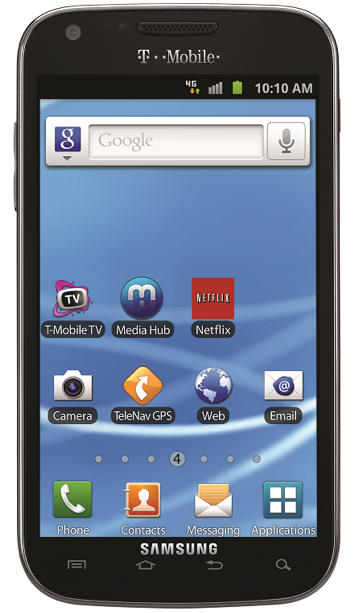Find Our Latest Video Reviews on YouTube!
If you want to stay on top of all of our video reviews of the latest tech, be sure to check out and subscribe to the Gear Live YouTube channel, hosted by Andru Edwards! It’s free!
Wednesday August 31, 2011 12:52 pm
Samsung Galaxy S II hands-on with Sprint, AT&T, T-Mobile models

The galaxy has landed. Samsung, AT&T, Sprint, and T-Mobile today announced three Galaxy S II smartphones for the three carriers. We got some time with the AT&T and Sprint models (T-Mobile was playing coy) and even ran some benchmarks.
The Galaxy S II has been Samsung's fastest-selling smartphone so far, with more than five million sold in 85 days, according to Samsung's press release. This model is coming out on fewer carriers than last year's Galaxy S did, with Verizon Wireless the most notable missing piece (Verizon is going with the Nexus Prime.)
But remember, Samsung is the master customizer of phones for carriers; just because a "Galaxy S II" isn't coming out for Verizon (or for Boost, for that matter) doesn't mean another phone won't appear soon with very similar features and a slightly different name on those carriers. The company is just introducing the first three models today.
Just like with the Galaxy S, the three Galaxy S II models are all a little different. The AT&T model looks a lot like the international Galaxy S II to which we gave an Editor's Choice award back in May, although Samsung traded the single home button at the bottom of the phone for the four standard Android action buttons.
Three Models Compared
Like the international model, the AT&T Galaxy S II is a slim, black slab with a 1.20-Ghz, dual-core Samsung Exynos processor, a 4.3-inch, 800-by-480 Super AMOLED Plus screen and a textured plastic back with a little lip at the bottom where the antenna goes. The Galaxy S II will be one of AT&T's few 4G phones, at least the way we describe 4G, meaning HSPA+ 21.
AT&T's bloatware includes Live TV, an account management app, Qik, Words with Friends, and a Yellow Pages app.
The Sprint version is also a black slab phone, but it's different. It has more rounded corners than the AT&T model, and no lip on the back. It sports a 4.5-inch screen (the same 800-by-480 resolution, though) and WiMax. Sprint bloatware on board includes Sprint Music Plus, Sprint Radio, Sprint TV and Movies, Sprint's Wi-Fi hotspot app, Sprint Mobile (a virtual credit-card thingie), and Sprint ID, Sprint's theme system for smartphones.
All the phones have 8-megapixel cameras on the back with 1080p HD video recording, and 2-megapixel cameras on the front. "Galaxy S II supports popular video conferencing services like Skype, Fring, Qik and Tango," Samsung's press release says. They all have 16GB of memory, along with a MicroSD card slot supporting 32GB cards.
Both phones run Google Android Gingerbread (2.3) with Samsung's TouchWiz extensions. New to these phones, Samsung has made it possible to create iOS-style folders in the app list, letting you arrange your downloaded apps into groups. Samsung Kies Air will let users sync content over Wi-Fi from their home PCs to their phones. Samsung added Vlingo's voice command system, which lets you dictate voice messages, and—a huge boon for reviewers like myself—an easy way to take screen shots on the phones.
Both phones have Samsung's Media Hub movie and TV store and support HDMI output, albeit through a hard-to-find MHL adapter—I'm hoping they include one of those in the box.
The Galaxy S II phones also use their accelerometers in unusual ways. Most notably, there's tilt-to-zoom: by tilting the phone, you can zoom in on Web pages. It's a gimmick, but a very cool one. Samsung's social networking, memo pad, and other apps familiar from the popular Galaxy S phones are here, too.
The T-Mobile model is a bit more mysterious—we weren't allowed hands-on time with that one—but Samsung's press release says it's 4G. That's something.
How The Galaxy S II Performs
So how about those benchmarks? We ran the Antutu system benchmark, the Nenamark 2 graphics benchmark, and the Browsermark browsing benchmark, all part of our standard smartphone benchmark suite.

As you can see in our benchmark chart, the AT&T and Sprint models benchmarked almost exactly the same. That makes sense; they have the same processors, same Android versions, and same screens. We couldn't finish BrowserMark on the AT&T unit because we ran out of time with the devices, but I think the result will come out the same as the Sprint model.
Overall, these appear to be the fastest Android phones yet, with higher benchmarks all around when compared to the cream of the current dual-core crop. I was especially impressed by the results on NenaMark; there's something going on in the Exynos GPU that's going to be terrific for gamers.
Sprint's Galaxy S II will come out on Sept. 16 for $199 with a two-year contract. We're still waiting for release details from AT&T and T-Mobile.
This article, written by Sascha Segan, originally appeared on PCMag.com and is republished on Gear Live with the permission of Ziff Davis, Inc.











